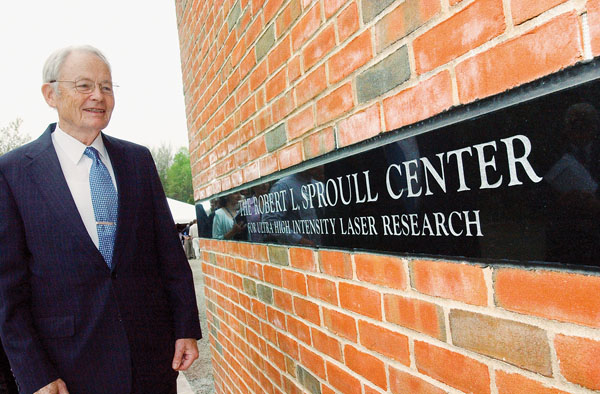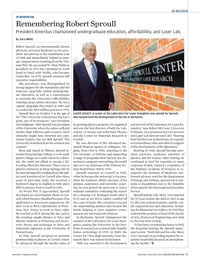In Review
 LASER LEGACY: A center at the Laboratory for Laser Energetics was named for Sproull, who helped lead the development of the
lab at Rochester. (Photo: University Communications)
LASER LEGACY: A center at the Laboratory for Laser Energetics was named for Sproull, who helped lead the development of the
lab at Rochester. (Photo: University Communications)Robert Sproull, an internationally known physicist, arrived at Rochester as vice president and provost in the tumultuous year of 1968 and immediately helped to manage campus unrest resulting from the Vietnam War. He succeeded W. Allen Wallis as president in 1970 but continued to work hand-in-hand with Wallis, who became chancellor. In 1975, Sproull assumed full executive responsibility.
His presidency was distinguished by strong support for the humanities and the sciences, especially within undergraduate education, as well as a commitment to maintain the University’s affordability, resisting steep tuition increases. He led a capital campaign that ended in 1980 and exceeded the $102 million goal set in 1975.
Sproull died on October 9 at the age of 96. “The University of Rochester has lost a giant, one of its treasures,” says President Joel Seligman. “Bob Sproull was president of the University when the nation suffered double-digit inflation and recession. Such obstacles might have diverted less committed leaders, but not Bob Sproull. The University benefited from his wisdom and counsel.”
Born and raised in Illinois, Sproull attended Deep Springs College, a work-study junior college on a cattle ranch in California. He could not afford to accept a fellowship offered by Harvard. There was no physics instructor at Deep Springs, but he became intrigued by reading about the subject and transferred to Cornell after three years of part-time study. He received a bachelor’s degree in English in 1940, and a PhD in physics from Cornell in 1943.
As World War II approached, Sproull developed an experimental thesis at Cornell, which became classified because of its application to microwave magnetrons. He then went to RCA Laboratories in Princeton, New Jersey, to work on Navy radar. He worked at RCA during the day, and in the evenings taught physics to Navy and Marine students at Princeton and microwave theory and technique to Navy and industrial engineers at the University of Pennsylvania.
In 1946, Sproull accepted an assistant professorship in physics at Cornell, where he advanced through the faculty ranks of its growing physics program. He organized and was the first director of both the Laboratory of Atomic and Solid State Physics and the Center for Materials Research at Cornell.
He was director of the Advanced Research Projects Agency in Arlington, Virginia, from 1963 to 1965, reporting to the U.S. Secretary of Defense and supporting a range of programs from nuclear test detection to computer networking. He would also serve as chairman of the Defense Science Board from 1968 to 1970.
Sproull returned to Cornell in 1965, when he became the university’s vice president for academic affairs. Because of his defense experience and scientific expertise, he was picked the next year to lead a national committee evaluating the search for a missing U.S. hydrogen bomb after a B-52 and an Air Force tanker crashed off the coast of Spain. His committee rescued the unpromising mission and located the bomb, helping to avert negative consequences for international relations.
At Rochester, Sproull championed the creation of the Laboratory for Laser Energetics, putting the University in the forefront of research on commercially feasible fusion technology in 1970. In 2005, the Center for Ultra High Intensity Laser Research there was named in his honor.
“Bob was essential to the development and survival of the Laboratory for Laser Energetics,” says Robert McCrory, University Professor, vice president and vice provost, and Laser Lab director and CEO. “Starting from his first year at Rochester, he expended extraordinary time and effort in support of the development of the laboratory.”
Retiring in 1984, Sproull became president emeritus, professor emeritus of physics, and life trustee. After retiring, he continued to lend his expertise to many corporate boards, chaired a committee of the National Academy of Sciences to reorganize the Institute of Medicine, performed advisory work for the departments of Energy and Defense, and served on missions to Kazakhstan and to the Republic of Georgia for the International Executive Service.
Sproull and his wife, Mary, were married for 70 years before she died in 2012 at age 93. She was a talented painter, and the couple supported arts and education, including the Memorial Art Gallery. In 1999 they endowed the position of dean of the faculty of Arts, Sciences & Engineering, now held by Provost Peter Lennie.
“It has been a tremendous honor to hold the deanship bearing the Sproull name,” says Lennie. “Both Bob and his wife, Mary, were visionary in providing support for academic leadership focused on strengthening the faculty.”

